Just as the borders in our garden begin to dim a little from late summer, and we start thinking of berries and autumn leaf colour, a surprising surge of floral energy re-emerges courtesy of a range of showy, autumn-flowering perennials. Many of these will bloom until the first frosts, extending the season of colour and interest, while providing insects with welcome supplies of late nectar and pollen.
Flowering in September, later than other heleniums in our garden, Helenium “The Bishop” delivers a long-lasting display of rich, buttercup-yellow daisies with prominent, dark brown centres. Loved by bees and butterflies, the flowers are carried in generous clusters on robust, leafy stems up to one metre tall. It’s an easy-to-grow and reliable performer that thrives with plenty of sunshine and a moist soil.
In another part of the garden, the tall-growing, perennial sunflower, Helianthus “Lemon Queen” sits quietly at the back of a border all through summer, waiting for its moment to shine. From early autumn, its upright stems are topped with branching sprays of gorgeous, pale lemon, daisy-like flowers.
Lower-growing, for the middle or front of a border, Rudbeckia fulgida var. sullivantii “Goldsturm” bears large, black-eyed, golden yellow, daisy flowers from August to October. It works well with ornamental grasses or the tall, violet blue spikes of Aconitum carmichaelii “Arendsii”.
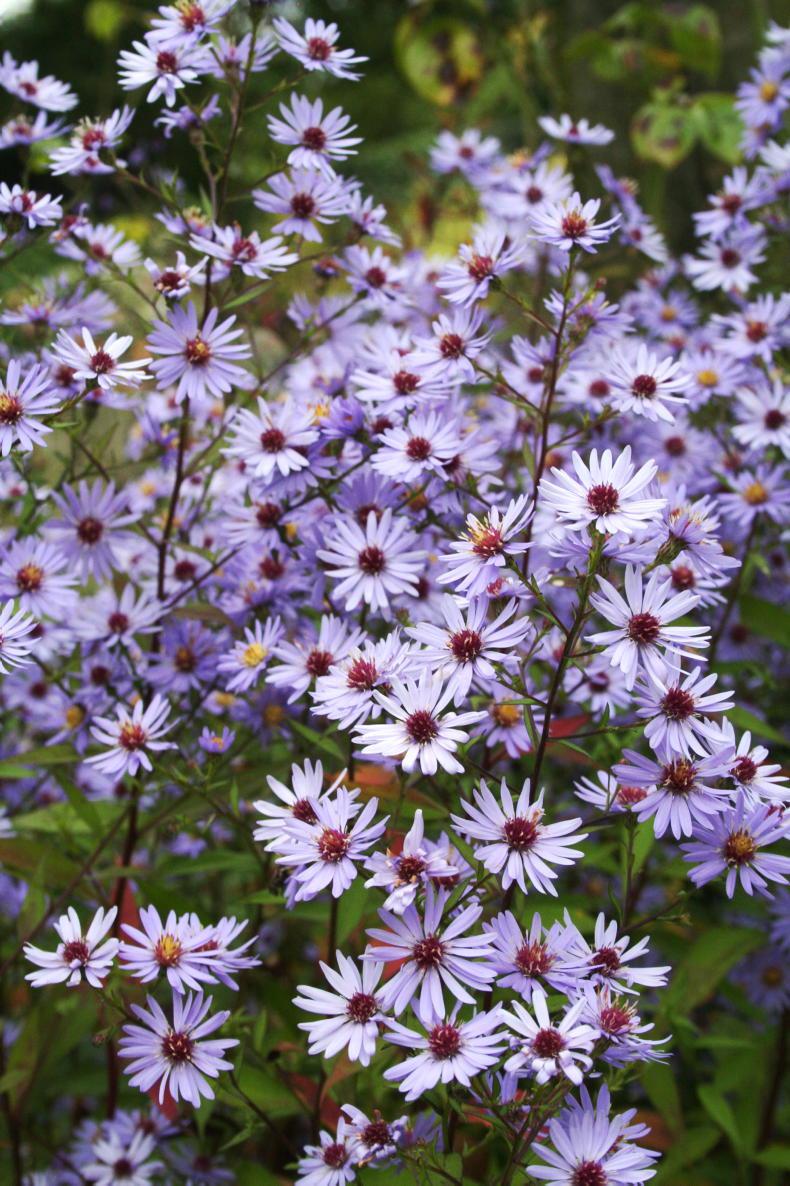
Michaelmas daisy Symphyotrichum 'Little Carlow' flowers profusely throughout autumn. \ Mary Keenan.
Commonly known as monkshood, it’s another fantastic, stately perennial for late-autumn flowering. Michaelmas daisies, formerly known as Aster and now classed botanically as Symphyotrichum, can always be relied on for late colour. Available in purple, blue, white, and pink and varying heights, they are easy to grow, and their single, daisy-like flowers are good for pollinators. Try mildew-resistant varieties like “Little Carlow” with its profusion of small, pale violet flowers or larger-flowered “Violetta” with masses of rich, violet-purple daisies with golden yellow centres.
Timely reminder
Apply nematodes now to
control vine weevils
U-shaped notches chewed out of the edges of leaves and plants wilting and collapsing owing to eaten roots are both evidence of vine weevils at work. Plants in containers are especially vulnerable to attack.
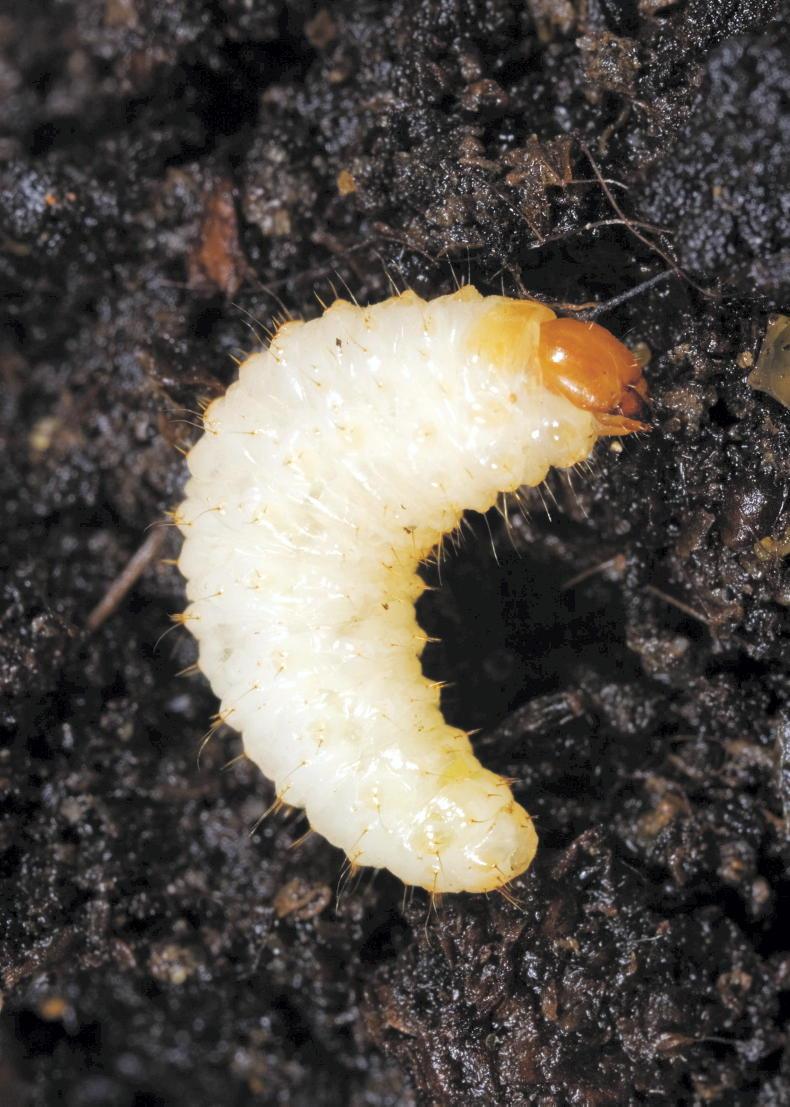
A larva of vine weevil.
The adult weevils eat plant leaves during spring and summer, but the most serious damage is caused over autumn, winter and early spring by their soil-dwelling larvae. These are small, creamy-white, c-shaped grubs with orange-brown heads and no legs. They feed on plant roots causing a decline in plant growth and often plant death. Plants such as strawberries, Bergenia, Primula, Tiarella and Heuchera are amongst their favourites.
If you’ve got vine weevil in your garden or containers, mid-August to early September is the optimum time to apply an organic, biological control based on parasitic nematodes. These are microscopic worms that kill the vine weevil larvae by entering their bodies and releasing lethal bacteria. The nematodes are available from mail order suppliers, such as fruithillfarm.com in Co Cork. Simply mix them with water and apply to the soil or compost with a watering can or sprayer. A moist growing medium and a minimum soil temperature of 5 degrees Celsius is essential for control to be effective. Nematodes can be used safely on all edible and ornamental plants.
Butterfly bonanza
Several autumn-flowering perennials are butterfly magnets and their colour and interest in the garden is augmented by the wildlife they attract. Commonly known as Joe Pye weed, Eupatorium maculatum “Purple Bush” is an imposing herbaceous perennial that particularly draws red admiral butterflies in our garden. Tall, purple-tinged stems, over two metres high, raise the broad, gently domed heads of tiny, dusky pink flowers well above their border companions. Rich, damp soil encourages lush growth and big flowers. At the front of a sunny border, closer to our house, is a large drift of the border sedum, Hylotelephium “Herbstfreude”, sometimes sold as H. “Autumn Joy”, which attracts hordes of tortoiseshell butterflies on warm autumn days. Blooming from August to November, above succulent, grey-green leaves, the large flat heads of flower buds are pale green and resemble heads of broccoli, before they open into masses of small, star-shaped, pink flowers which darken to claret as they age. These are carried on robust stems up to 60 cm high and will continue to look good into winter if you leave their dark brown seedheads in place to be decorated by frost and snow.
This month’s to-do list
Restore a sense of order and neatness to borders by cutting back perennials that have finished flowering.Plant spring-flowering bulbs into containers and garden borders.Trim back hedges now that the birds are finished with nesting and fledging.Lift, divide and replant congested clumps of early-flowering perennials while the soil is still warm and moist.Wash and disinfect bird feeders in preparation for winter feeding to maintain hygiene.Sunday 10 September 2023: Autumn Plant Fair at Fota House, Cobh, Co Cork in association with Irish Specialist Nursery Association. Time: 11am to 4pm. Specialist plant nurseries and other stalls selling garden-related items. Sunday 10 September: Joint lecture by Jimi Blake and Conall O’Caoimh, “Sculpture in the garden - the importance of creativity and art in our outside space”. Time: 3-4pm. Venue: National Botanic Gardens, Glasnevin, Dublin as part of the Sculpture in Context exhibition which runs from 7 September to Friday, 13 October.5-7 October: The Northern Ireland Heritage Gardens Trust annual conference. Theme: “Robinsonian gardening — a living legacy” focussing on the life, work and gardening influence of the Irish gardener and writer William Robinson (1838-1935). Venue: Mount Errigal Hotel, Letterkenny, Co Donegal. More information: www.nihgt.orgGarden club events nationwide: Check out listings in The Irish Garden magazine, local newspapers, club websites and social media.Mary Keenan and Ross Doyle run Gash Gardens, Co Laois open to the public. www.gashgardens.ie Read more
Mary Keenan's Garden Diary: mind the gaps
Mary Keenan's Garden Diary: Terrace time
Just as the borders in our garden begin to dim a little from late summer, and we start thinking of berries and autumn leaf colour, a surprising surge of floral energy re-emerges courtesy of a range of showy, autumn-flowering perennials. Many of these will bloom until the first frosts, extending the season of colour and interest, while providing insects with welcome supplies of late nectar and pollen.
Flowering in September, later than other heleniums in our garden, Helenium “The Bishop” delivers a long-lasting display of rich, buttercup-yellow daisies with prominent, dark brown centres. Loved by bees and butterflies, the flowers are carried in generous clusters on robust, leafy stems up to one metre tall. It’s an easy-to-grow and reliable performer that thrives with plenty of sunshine and a moist soil.
In another part of the garden, the tall-growing, perennial sunflower, Helianthus “Lemon Queen” sits quietly at the back of a border all through summer, waiting for its moment to shine. From early autumn, its upright stems are topped with branching sprays of gorgeous, pale lemon, daisy-like flowers.
Lower-growing, for the middle or front of a border, Rudbeckia fulgida var. sullivantii “Goldsturm” bears large, black-eyed, golden yellow, daisy flowers from August to October. It works well with ornamental grasses or the tall, violet blue spikes of Aconitum carmichaelii “Arendsii”.

Michaelmas daisy Symphyotrichum 'Little Carlow' flowers profusely throughout autumn. \ Mary Keenan.
Commonly known as monkshood, it’s another fantastic, stately perennial for late-autumn flowering. Michaelmas daisies, formerly known as Aster and now classed botanically as Symphyotrichum, can always be relied on for late colour. Available in purple, blue, white, and pink and varying heights, they are easy to grow, and their single, daisy-like flowers are good for pollinators. Try mildew-resistant varieties like “Little Carlow” with its profusion of small, pale violet flowers or larger-flowered “Violetta” with masses of rich, violet-purple daisies with golden yellow centres.
Timely reminder
Apply nematodes now to
control vine weevils
U-shaped notches chewed out of the edges of leaves and plants wilting and collapsing owing to eaten roots are both evidence of vine weevils at work. Plants in containers are especially vulnerable to attack.

A larva of vine weevil.
The adult weevils eat plant leaves during spring and summer, but the most serious damage is caused over autumn, winter and early spring by their soil-dwelling larvae. These are small, creamy-white, c-shaped grubs with orange-brown heads and no legs. They feed on plant roots causing a decline in plant growth and often plant death. Plants such as strawberries, Bergenia, Primula, Tiarella and Heuchera are amongst their favourites.
If you’ve got vine weevil in your garden or containers, mid-August to early September is the optimum time to apply an organic, biological control based on parasitic nematodes. These are microscopic worms that kill the vine weevil larvae by entering their bodies and releasing lethal bacteria. The nematodes are available from mail order suppliers, such as fruithillfarm.com in Co Cork. Simply mix them with water and apply to the soil or compost with a watering can or sprayer. A moist growing medium and a minimum soil temperature of 5 degrees Celsius is essential for control to be effective. Nematodes can be used safely on all edible and ornamental plants.
Butterfly bonanza
Several autumn-flowering perennials are butterfly magnets and their colour and interest in the garden is augmented by the wildlife they attract. Commonly known as Joe Pye weed, Eupatorium maculatum “Purple Bush” is an imposing herbaceous perennial that particularly draws red admiral butterflies in our garden. Tall, purple-tinged stems, over two metres high, raise the broad, gently domed heads of tiny, dusky pink flowers well above their border companions. Rich, damp soil encourages lush growth and big flowers. At the front of a sunny border, closer to our house, is a large drift of the border sedum, Hylotelephium “Herbstfreude”, sometimes sold as H. “Autumn Joy”, which attracts hordes of tortoiseshell butterflies on warm autumn days. Blooming from August to November, above succulent, grey-green leaves, the large flat heads of flower buds are pale green and resemble heads of broccoli, before they open into masses of small, star-shaped, pink flowers which darken to claret as they age. These are carried on robust stems up to 60 cm high and will continue to look good into winter if you leave their dark brown seedheads in place to be decorated by frost and snow.
This month’s to-do list
Restore a sense of order and neatness to borders by cutting back perennials that have finished flowering.Plant spring-flowering bulbs into containers and garden borders.Trim back hedges now that the birds are finished with nesting and fledging.Lift, divide and replant congested clumps of early-flowering perennials while the soil is still warm and moist.Wash and disinfect bird feeders in preparation for winter feeding to maintain hygiene.Sunday 10 September 2023: Autumn Plant Fair at Fota House, Cobh, Co Cork in association with Irish Specialist Nursery Association. Time: 11am to 4pm. Specialist plant nurseries and other stalls selling garden-related items. Sunday 10 September: Joint lecture by Jimi Blake and Conall O’Caoimh, “Sculpture in the garden - the importance of creativity and art in our outside space”. Time: 3-4pm. Venue: National Botanic Gardens, Glasnevin, Dublin as part of the Sculpture in Context exhibition which runs from 7 September to Friday, 13 October.5-7 October: The Northern Ireland Heritage Gardens Trust annual conference. Theme: “Robinsonian gardening — a living legacy” focussing on the life, work and gardening influence of the Irish gardener and writer William Robinson (1838-1935). Venue: Mount Errigal Hotel, Letterkenny, Co Donegal. More information: www.nihgt.orgGarden club events nationwide: Check out listings in The Irish Garden magazine, local newspapers, club websites and social media.Mary Keenan and Ross Doyle run Gash Gardens, Co Laois open to the public. www.gashgardens.ie Read more
Mary Keenan's Garden Diary: mind the gaps
Mary Keenan's Garden Diary: Terrace time










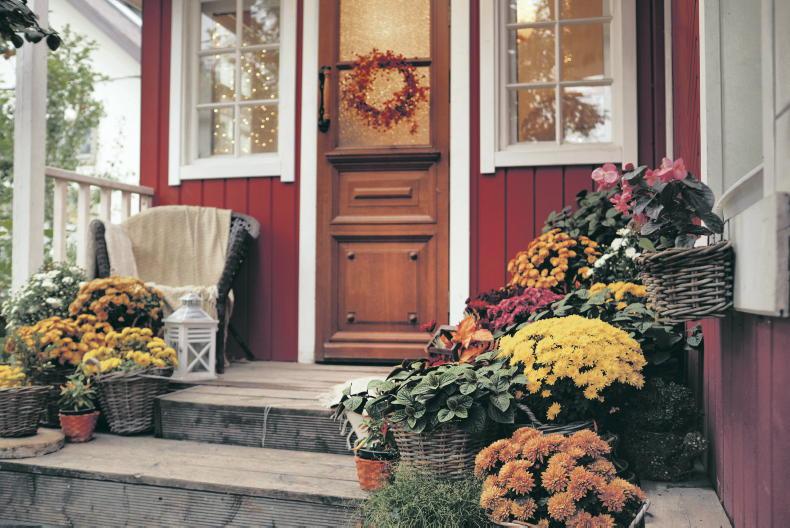
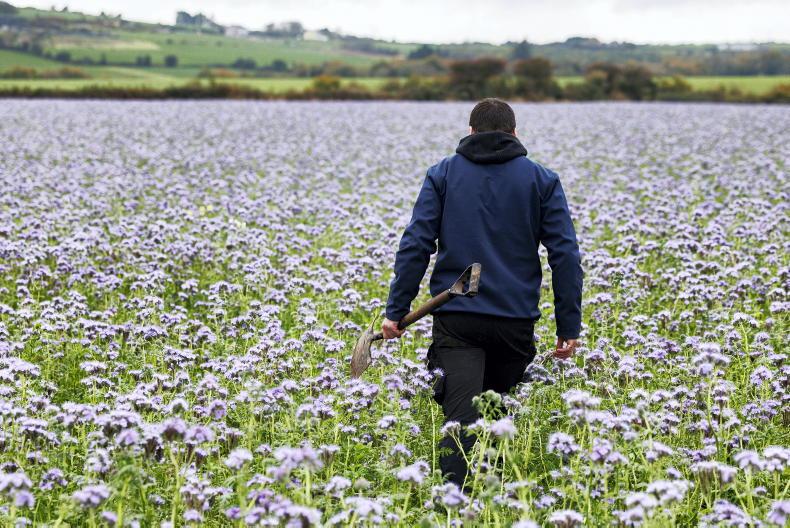

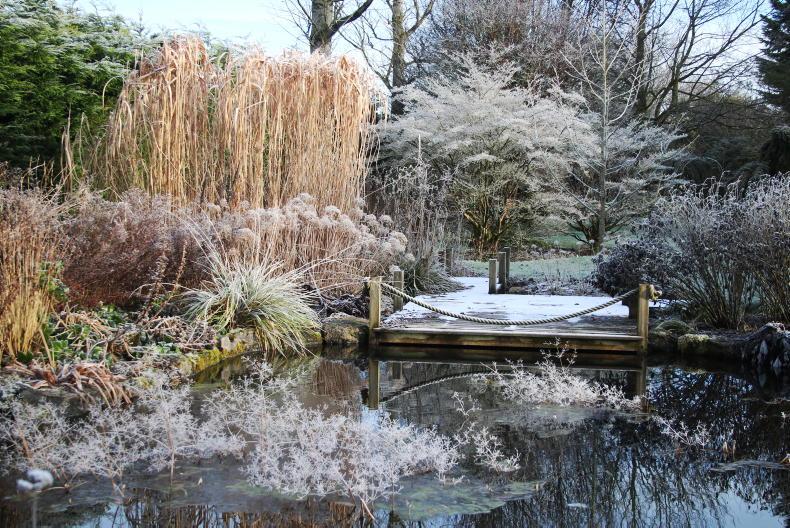
SHARING OPTIONS